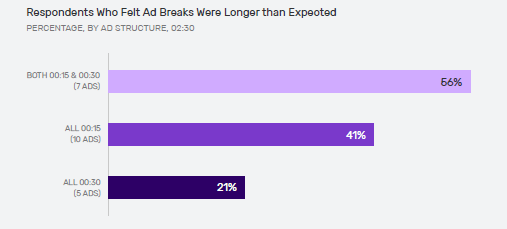Advertising has made its way into streaming and recent research has shown consumers are warming up to ad-supported plans amid increasing prices. And while advertising represents an opportunity for publishers to generate revenue and brands to get in front of eyeballs, serving up ads also means the potential to disrupt or degrade the viewing experience.
New research released this week from Comcast’s FreeWheel unit doles out advice on how to optimize the ad pod length, architecture and ad frequency to drive a better viewing experience as well as brand results for recall and purchase intent. The findings, developed in partnership with MediaScience, are a result of the ad tech company’s Viewer Experience Lab. The lab is an initiative formed in 2023 with the aim of conducting research into how viewers respond to ad formats and developing new solutions to help media companies ensure a positive ad experience across what has become a highly fragmented TV viewing and ad buying ecosystem.
For the study, 700 viewers participated in at-home or in-lab viewing environments where they were shown programming that had different ad pod lengths, ad durations and frequencies. The findings are based on real-time surveys to gauge consumers’ perception of the ad experience and test ad recall.
“With so much choice for consumers on how and where they engage with content, it’s more important than ever that platforms prioritize the viewer,” said Mark McKee, general manager at FreeWheel, in a statement. “This research provides practical considerations for publishers to make the ad experience better and limit subscription churn, while giving brands the best environment to connect with viewers.”
Here are some of the key findings:
- According to FreeWheel, when it comes to pod length, ad breaks of two minutes or less are optimal and can improve both brand impact and ad experience.
Consumers in the study had similar perceptions of ad intrusiveness for ad pods that ran one or two minutes in length. But once ad pods reached three minutes, the number of viewers who felt the ads were intrusive doubled. Most also feel the two-minute mark for an ad pod is reasonable. The study found that 62% of participants felt two-minute ad breaks were in line with their expectations, while 45% of participants felt one minute ad breaks were shorter than expected.
And longer ad breaks don’t equate to better recall – in fact, when ad pod length increased from two minutes to three minutes, ad recall was cut by more than half – dropping from 33% for two-minute pods to just 15% for three-minute pods.
- Consumers also appear to like consistency in terms of ad lengths within each ad pod or break – a best practice that helps enhance both the ad experience by making breaks feel shorter and improves sentiment towards ads viewed, per the report.
According to FreeWheel, when individual ad breaks grouped ads of the same length viewers reported liking the commercials more (a 5% increase over pods with mixed lengths) and viewed ads as more innovative (a 7% bump for pods with consistent lengths over mixed), which the company said is likely attributed to the fact that they knew what to expect.
The results show that even when fewer ads were shown in a break (in this case seven), if the lengths were a mix of both 15-second and 30-second ads, over half (56%) felt the ad break was longer than expected. Comparatively, only 41% felt that way when they saw all 15-second ads (for a total of 10), and less than a quarter (21%) reported that sentiment when they viewed all 30-second ads (five in total).

- Finally, FreeWheel zeroed in on ad frequency, where it found capping of each ad at two to three per program can boost ad recognition and brand purchase intent.
“Creative repetition is referred to as an industry problem, but when viewers saw the same ad twice in a single 30-minute program, ad recognition and brand purchase intent increased by 22%. Further, recognition and purchase intent remained high at three exposures within a 30-minute program,” FreeWheel wrote in its report.
The findings come as several streaming services including Netflix, Disney+ and others have launched and are looking to build up ad-supported subscription streaming bases, while also experimenting with new types of ad formats. Amazon is the latest streamer to get into the ad-supported game with plans to introduce advertising on Prime Video subscriptions later this month. However, churn continues to be a significant industry issue, and most can’t afford to risk hurting the viewing experience and potentially turning consumers off to a service because of intrusive advertising.
“This is ground-breaking research that empowers media planners to best capitalize on their investment,” said Dr. Duane Varan, CEO, MediaScience, in a statement. “By applying a research-based approach to a commonsense problem, the findings finally give due regard to key characteristics of the ad pod, while also optimizing the ad environment for viewers. It’s win-win all around."